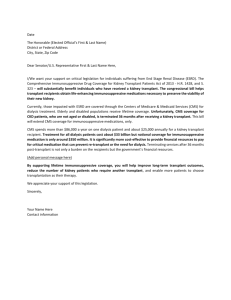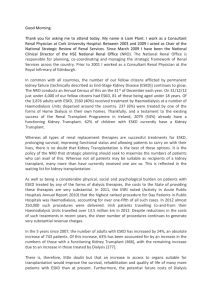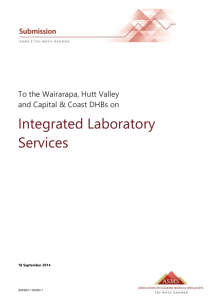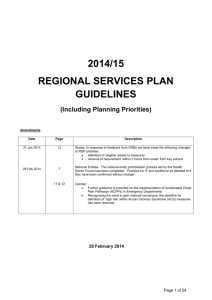Kidney Transplant Activity New Zealand
advertisement
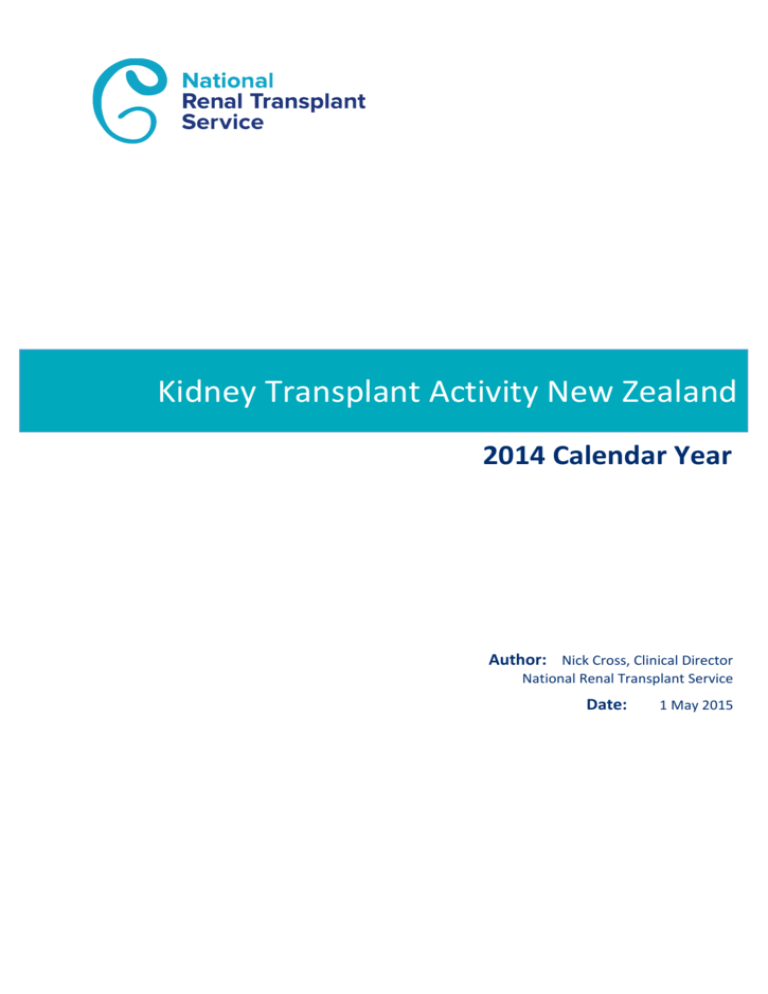
Kidney Transplant Activity New Zealand 2014 Calendar Year Author: Nick Cross, Clinical Director National Renal Transplant Service Date: 1 May 2015 Data Collection Data is provided directly to the National Renal Transplantation Service (NRTS) from the three Transplanting Units and from individual units to the Australian and New Zealand Dialysis and Transplantation Registry (ANZDATA), provided via the National Renal Advisory Board (NRAB). Transplantation Services in New Zealand Kidney transplantation is treatment for end stage kidney patients who would otherwise be on lifelong dialysis. Dialysis and transplantation are collectively referred to as renal replacement therapy. Transplantation provides better quality of life, reduces risk of morbidity and mortality, and is less costly than dialysis for patients eligible to undergo transplantation. Within New Zealand there are three types of district health boards (DHBs), with respect to provision of transplantation services: 1) Transplanting DHBs – these DHBs provide kidney transplantation services for their local population and several other DHBs. These DHBs also have comprehensive dialysis services. There are three of these. 2) Referring DHBs with “comprehensive” dialysis services. These DHBs provide their own dialysis services without any involvement from other DHBs. There are eight of these. 3) DHBs without comprehensive dialysis services. These DHBs are dependent on referring or transplanting DHBs for at least part of their dialysis service. There are 9 of these. Data presented by DHBs without comprehensive dialysis services include other DHBs as noted in Table 2. Please note that “comprehensive” is an arbitrary distinction. For example, Nelson/Marlborough provides many dialysis services (with support from Wellington for some elements only), but is included in Capital & Coast DHB’s figures. Three district health boards (Auckland, Capital & Coast and Canterbury) provide kidney transplantation procedures (living and deceased donor transplants) regionally (labelled “Auckland”, “Wellington” and “Christchurch”). Assessment of recipients and potential living donors is complex and is, at least partially, provided by referring DHBs in many cases. Referring DHBs send patients to a single transplant centre for routine transplants. Auckland DHB provides multi-organ transplants (kidney plus another organ) and paediatric transplantation for the entire country. ABO incompatible transplantation is provided in Auckland and Christchurch only. The arrangements of DHBs into three regional transplantation services is shown in Figure 1. Some patients are, therefore, dependent on services provided via three DHBs for access to transplantation. Transplant rates are presented per 100 dialysis patients. It should be noted that not all dialysis patients are suitable for transplantation, due to coexistent comorbidities. This may explain some variability between units. No attempt is made to adjust for differences in comorbidities in populations cared for by different renal units. Transplanting DHBs provide the immediate after care following transplantation, with recipients and donors returning to their DHB of domicile for long term care. National Renal Transplant Service | Kidney Transplant Activity NZ 2014 Calendar Year Page | 2 Figure 1: Arrangement of DHBs for Provision of Kidney Transplantation Services National Renal Transplant Service | Kidney Transplant Activity NZ 2014 Calendar Year Page | 3 Total Transplants performed in New Zealand There were 138 kidney transplants performed in New Zealand in 2014 (30.3 per million population (pmp)). This is 27% more and 2.7 standard deviations greater than the average of the last ten years (mean 109.1, standard deviation 10.9 transplants per year). This included 72 living donor and 66 deceased donor kidney transplants. There were two living donor kidney exchange chains (each comprising two transplants). This is the largest total number of kidney transplants performed in New Zealand in a calendar year (previous greatest was 123 in 2007). At the currently estimated population of 4.56 million, this is the first time New Zealand’s (NZ’s) total per million population transplant rate has exceeded 30 (previous highest was 29.7 in 2002, comprising 17.5 pmp transplants from deceased donors and 12.2 pmp transplants from living donors). Table 1: Transplant Characteristics by Transplant Centre Kidney Transplants Living donor, n (%) Deceased donor, n (%) Auckland 88 40 (45) 48 (55) Wellington 32 18 (56) 14 (44) Christchurch 18 14(78) 4 (22) Overall 138 72(52) 66(48) Pmp 30.3 15.8 14.5 Compared to the most recent data available from WHO (2010), NZ’s 2014 results would place it 33rd of 70 countries reporting deceased kidney donor transplantation activity and 17th of 81 countries reporting living kidney donor transplantation activity per million population. Transplants per 100 Dialysis Patients, by dialysis unit and DHB of domicile Overall, there were 5.3 kidney transplants per 100 dialysis patients in New Zealand in 2014. This was a substantial increase on the annual average of 4.6, from the three prior years. There was an improvement in the rate of transplants per 100 dialysis patients at a number of DHBs compared to the mean values from the prior three years (notably at Waitemata, Auckland, Counties Manukau, MidCentral and Capital & Coast DHBs). Only two DHBs recorded a reduction in the rate of transplant per 100 dialysis patients in 2014 compared to the mean of the prior three years. Although Canterbury had a reduction, it still had the highest transplantation rate of any DHB. Hawke’s Bay is one of the smaller units and, as such, may expect greater year to year variability in this measure. National Renal Transplant Service | Kidney Transplant Activity NZ 2014 Calendar Year Page | 4 Table 2: Transplants by DHB of Domicile Deceased Donor Living Donor Total Dialysis Prevalent Numbers (2013) Transplants per 100 Dialysis Patients 2014 Starship Auckland Region Northland Waitemata Auckland Counties Manukau Waikato (includes BOP, Lakes, Tairawhiti) Taranaki Wellington Region Hawke’s Bay MidCentral (includes Whanganui) Capital & Coast (includes Wairarapa, Hutt, Nelson/Marlborough) Christchurch Region Canterbury (includes West Coast, South Canterbury) Southern Total Annual Mean 2011-2013 69 3.3 4.5 1 45 4 10 9 13 3 35 5 5 6 11 4 80 9 15 15 24 8 1861 164 288 309 576 50 4.3 5.5 5.2 4.9 4.2 9 5 14 472 3.0 2.8 0 15 0 3 19 2 3 34 2 52 485 97 5.8 7.0 2.1 5.8 6.4 7.1 7 4 11 138 8.0 4.1 8 13 21 250 8.4 6.9 5 14 19 230 8.3 9.7 4 8 12 135 8.9 11.7 1 66 6 71 7 137 95 2584 7.4 5.3 7.1 4.6 3.63 2.7 Notes on table 2: 1. DHB of domicile is the recipients, at discharge from hospital. Living donors may come from different DHBs to their recipients. 2. Transplants per 100 prevalent dialysis patients at 31 December the year prior, per ANZDATA. 3. Annual Mean 2011-2013 for Auckland and Waitemata provided as a single unit (as they were for part of that period). 4. Private paying non-eligible patients (e.g. overseas residents, one in 2014) not included here. 5. Paediatric patients <=16 years, managed via Starship and transplanted in Auckland, are excluded from DHB of domicile. Multi-organ Transplantation (all Auckland) In 2014, there were two kidney-pancreas transplants performed (DHB of Domicile: Canterbury and Mid-Central) and one liver-kidney (DHB of Domicile: Waitemata). These are included above. ABO Incompatible (ABOi) ABOi are performed at Auckland and Christchurch, using a similar protocol (developed in Auckland). All ABOi are living donor transplants. There were seven ABOi in 2014, five in Auckland (DHB of Domicile: Waitemata (two), Counties Manukau, Capital and Coast, Taranaki) and two in Canterbury (both DHB of domicile: Canterbury). National Renal Transplant Service | Kidney Transplant Activity NZ 2014 Calendar Year Page | 5

